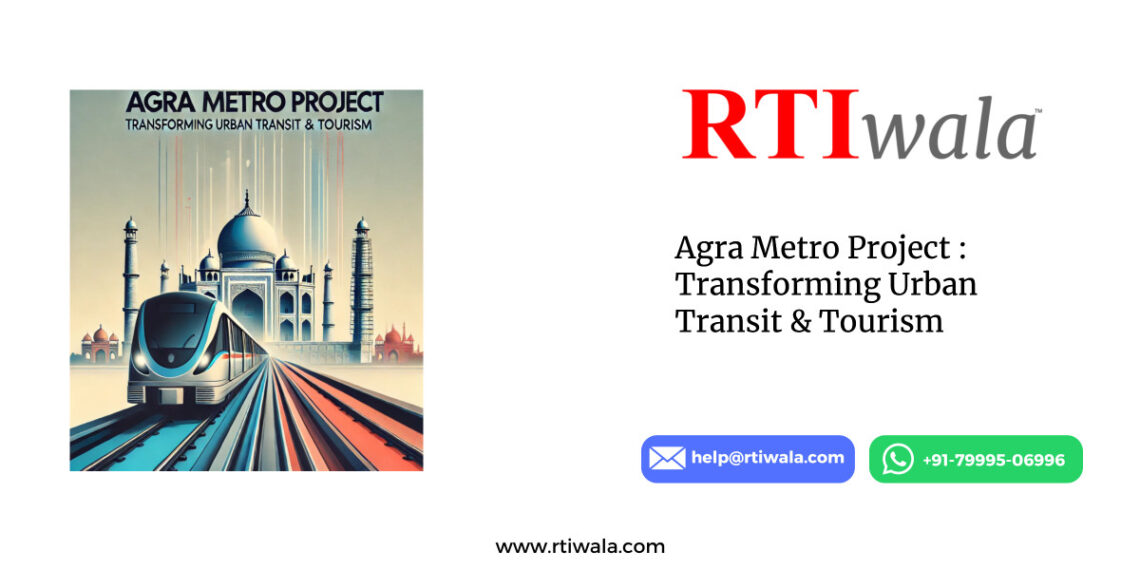Introduction
The Agra Metro Project is an ambitious initiative by the Government of Uttar Pradesh to modernize urban mobility in Agra, one of India’s most iconic tourist destinations. Designed to reduce traffic congestion and promote sustainable transportation, the project aims to provide world-class travel experiences for residents and visitors while preserving Agra’s cultural and historical legacy.
This article highlights the objectives, features, and progress of the Agra Metro Project, emphasizing its role in reshaping the city’s infrastructure and boosting tourism.
What is the Agra Metro Project?
The Agra Metro Project is a rapid transit system developed under the guidance of the Uttar Pradesh Metro Rail Corporation (UPMRC). Covering two major corridors, the metro system will connect key residential, industrial, and tourist areas, including the Taj Mahal, Agra Fort, and Sikandra.
Key Features:
- Eco-Friendly Design:
- Promotes green energy through solar-powered systems and energy-efficient technology.
- Tourist-Friendly Infrastructure:
- Integrates easy access to Agra’s UNESCO World Heritage sites and other landmarks.
- Modern Technology:
- Equipped with advanced safety features, digital ticketing systems, and accessibility for differently-abled passengers.
Objectives of the Agra Metro Project
- Enhance Urban Mobility:
- Provide a fast, reliable, and efficient transit system for Agra’s growing population and tourist influx.
- Reduce Traffic Congestion:
- Alleviate pressure on Agra’s road network, especially in areas surrounding major tourist attractions.
- Promote Sustainable Transportation:
- Minimize vehicular emissions and promote eco-friendly urban transit.
- Boost Tourism:
- Improve accessibility to Agra’s heritage sites, enhancing the experience for visitors.
- Support Economic Growth:
- Facilitate connectivity to industrial and commercial zones, fostering local business development.
Key Features of the Agra Metro
1. Metro Corridors
- Corridor 1 (Sikandra to Taj East Gate):
- Spanning 14 km with 13 stations, this line connects Sikandra to the Taj Mahal via major landmarks like Agra Cantt and Agra Fort.
- Corridor 2 (Agra Cantt to Kalindi Vihar):
- Covers 15.4 km with 14 stations, linking residential and industrial hubs.
2. Modern Train Design
- Fully air-conditioned, energy-efficient trains with a capacity to carry over 960 passengers per trip.
- Accessibility features include ramps, lifts, and designated seating for differently-abled individuals.
3. Tourist-Focused Services
- Easy connectivity to major attractions like the Taj Mahal, Agra Fort, and Fatehpur Sikri.
- Dedicated signage and information systems for tourists.
4. Sustainability Initiatives
- Solar panels installed at stations to power operations.
- Use of regenerative braking systems to save energy.
5. Smart Ticketing System
- Contactless smart cards and QR-code-based mobile ticketing for hassle-free commuting.
Progress and Timeline
Current Status:
- Construction began in December 2020 with a focus on Corridor 1 as the priority line.
- Key milestones include the launch of metro depot construction and trial runs for the initial stretch.
Expected Timeline:
- The first phase is expected to be operational by 2024.
- The full project, including both corridors, is projected for completion by 2026.
Benefits of the Agra Metro Project
1. Time-Saving Transit
- Significantly reduces travel time across the city, particularly during peak hours.
2. Environmental Impact
- Encourages a shift from private vehicles to public transport, reducing carbon emissions and air pollution.
3. Boost to Tourism
- Facilitates smooth and efficient transportation for millions of domestic and international tourists visiting Agra annually.
4. Economic Upliftment
- Enhances access to commercial zones and employment hubs, supporting local economic development.
5. Improved Quality of Life
- Provides a safe, reliable, and modern transportation option for residents, easing daily commutes.
Challenges and Solutions
Challenges:
- Managing construction in densely populated areas without disrupting local activities.
- Preserving the city’s historical and cultural heritage during development.
Solutions:
- Use advanced construction techniques like elevated tracks and tunneling to minimize disruptions.
- Collaborate with heritage conservation experts to ensure infrastructure development aligns with Agra’s historical legacy.
Integration with Agra’s Urban Development
The Agra Metro Project is part of a larger urban development vision for the city:
- Smart City Initiatives:
- Aligns with Agra’s Smart City projects, enhancing infrastructure and public services.
- Transit-Oriented Development (TOD):
- Promotes commercial and residential growth near metro stations, creating vibrant economic zones.
- Eco-Friendly Urban Mobility:
- Complements citywide efforts to promote green transportation options like e-rickshaws and bicycles.
Conclusion
The Agra Metro Project is a transformative initiative that promises to redefine urban mobility in one of India’s most iconic cities. By offering a modern, eco-friendly, and efficient transit system, the project not only addresses the city’s transportation challenges but also boosts tourism and supports economic growth.
















































